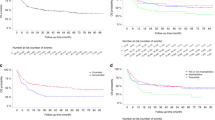Abstract
Thanks to advances in treatment, approximately 85–90% of patients suffering from Wilms’ tumour are now cured. However, success rate after relapse is significantly lower, ranging from 25 to 45%. Several different re-induction approaches, more or less intensive according to first-line therapy and characteristics of relapse, have been proposed. A number of adverse prognostic factors related to a bad outcome after relapse have been identified and are used as inclusion criteria for entering in a programme including high-dose chemotherapy (HCT). HCT followed by autologous haematopoietic stem cell rescue has been used in small numbers of patients worldwide and promising results have been reported. Information from the European Group for Blood and Marrow Transplantation Database regarding more than 300 transplants have been gathered. In addition, literature data on rescue therapy and HCT will be discussed, such as recent treatment proposals currently under discussion within European and US cooperative groups.
This is a preview of subscription content, access via your institution
Access options
Subscribe to this journal
Receive 12 print issues and online access
$259.00 per year
only $21.58 per issue
Buy this article
- Purchase on Springer Link
- Instant access to full article PDF
Prices may be subject to local taxes which are calculated during checkout

Similar content being viewed by others
References
Metzger ML, Dome JS . Current therapy for Wilms’ tumor. Oncologist 2005; 10: 815–826.
Pein F, Rey A, de Kraker J, Ludwig R, Pötter R, Godzinsky J et al. Multivariate analysis of adverse prognostic factors (APF) in children with recurrent (Rec) Wilms’ tumor (WT) after initial treatment according to SIOP-6 or SIOP-9 strategies. Med Pediatr Oncol 1999; 33: 170 (abstract no. 111).
Grundy P, Breslow N, Green DM, Sharples K, Evans A, D’Angio GJ . Prognostic factors for children with recurrent Wilms’ Tumor: results from the second and third National Wilms’ Tumor Study. J Clin Oncol 1989; 7: 638–647.
Dome JS, Liu T, Krasin M, Lott L, Shearer P, Daw NC et al. Improved survival for patients with recurrent Wilms tumor: the experience at St Jude Children's Research Hospital. J Pediatr Hematol Oncol 2002; 24: 192–198.
Pein F, Tournade MF, Zucker JM, Brunat-Mentigny M, Deville A, Boutard P et al. Etoposide and carboplatin: a highly effective combination in relapsed or refractory Wilms’ tumor—a phase II study by the French Society of Pediatric Oncology. J Clin Oncol 1994; 12: 931–936.
Abu-Ghosh AM, Krailo MD, Goldman SC, Slack RS, Davenport V, Morris E et al. Ifosfamide, carboplatin and etoposide in children with poor-risk relapsed Wilms’ tumor: a Children's Cancer Group report. Ann Oncol 2002; 13: 460–469.
Garaventa A, Hartmann O, Bernard JL, Zucker JM, Pardo N, Castel V et al. Autologous bone marrow transplantation for pediatric Wilms’ tumor: the experience of the European bone marrow transplantation solid tumor registry. Med Pediatr Oncol 1994; 22: 11–14.
Kullendorff CM, Bekassy AN . Salvage treatment of relapsing Wilms’ tumour by autologous bone marrow transplantation. Eur J Pediatr Surg 1997; 7: 177–179.
Pein F, Michon J, Valteau-Couanet D, Quintana E, Frappaz D, Vannier JP et al. High-dose melphalan, etoposide, and carboplatin followed by autologous stem-cell rescue in pediatric high-risk recurrent Wilms’ tumor: A French Society of Pediatric Oncology Study. J Clin Oncol 1998; 16: 3295–3301.
Kremens B, Gruhn B, Klingebiel T, Hasan C, Laws HJ, Koscielniak E et al. High-dose chemotherapy with autologous stem cell rescue in children with nephroblastoma. Bone Marrow Transplant 2002; 30: 893–898.
Campbell AD, Cohn SL, Reynolds M, Seshadri R, Morgan E, Geissler G et al. Treatment of relapsed Wilms’ tumor with high-dose therapy and autologous hematopoietic stem-cell rescue: the experience at Children's Memorial Hospital. J Clin Oncol 2004; 22: 2885–2890.
Spreafico F, Bisogno G, Collini P, Jenkner A, Gandola L, D’Angelo P et al. Treatment of high-risk relapsed wilms tumor with dose-intensive chemotherapy, marrow-ablative chemotherapy, and autologous hematopoietic stem cell. Support: Experience by the Italian Association of Pediatric Hematology and Oncology. Pediatr Blood Cancer doi: 10.1002/pbc.21524.
Acknowledgements
We thank Sara Calmanti for her assistance in editing the paper and Mrs Valerie Perricone for reviewing the text. This study has been supported in part by the Italian Ministry of Health, Programma di Ricerca Finalizzata ex articolo 12 D.L.gs 502/92 2005 ‘Assistenza Domiciliare in Bambini ed Adulti affetti da Patologie Emato-Oncologiche’.
Author information
Authors and Affiliations
Consortia
Corresponding author
Additional information
Conflict of interest
None of the authors declared any financial interests.
Rights and permissions
About this article
Cite this article
Dallorso, S., Dini, G., Faraci, M. et al. SCT for Wilms’ tumour. Bone Marrow Transplant 41 (Suppl 2), S128–S130 (2008). https://doi.org/10.1038/bmt.2008.70
Published:
Issue Date:
DOI: https://doi.org/10.1038/bmt.2008.70
Keywords
This article is cited by
-
Outcomes following autologous hematopoietic stem cell transplant for patients with relapsed Wilms’ tumor: a CIBMTR retrospective analysis
Bone Marrow Transplantation (2017)



